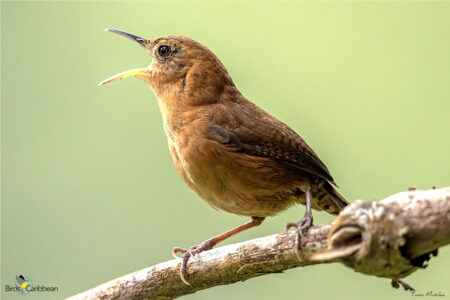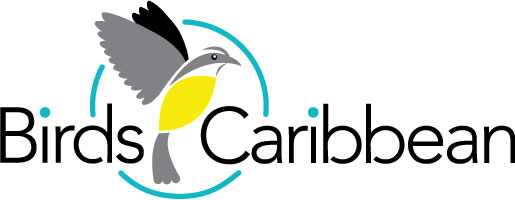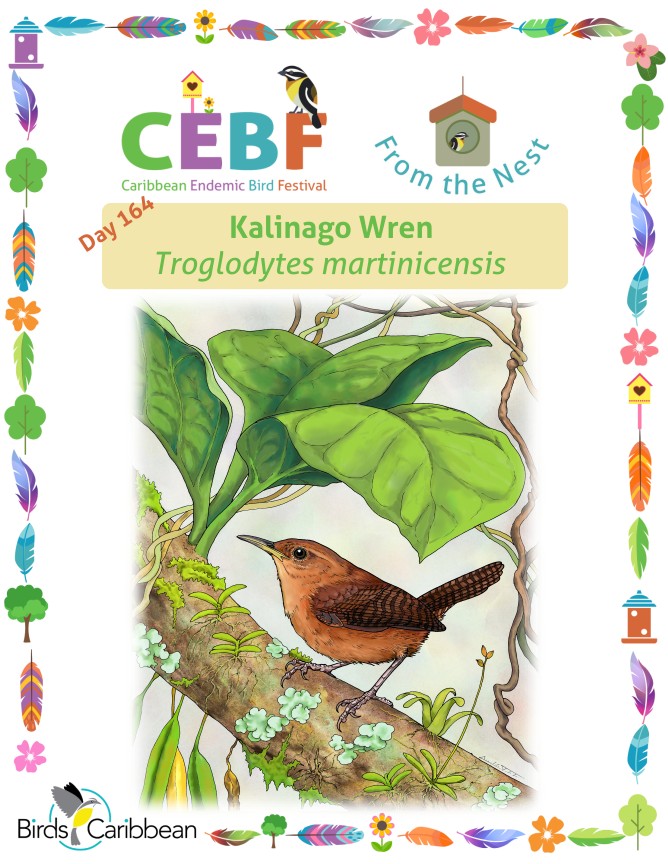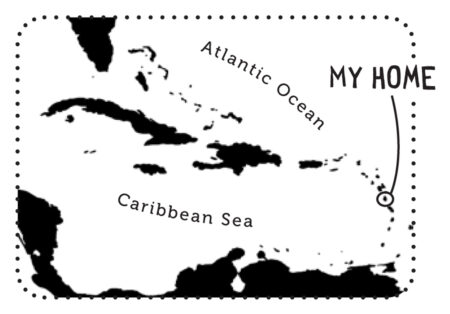Celebrate the Caribbean Endemic Bird Festival (CEBF) with us! Our theme in 2025 is “Shared Spaces: Creating Bird-friendly Cities and Communities”—highlighting the crucial role bird-friendly cities and communities can have in addressing the decline in bird populations caused by threats like habitat loss, predation, and climate change. Have fun learning about a new endemic bird every day. We have colouring pages, puzzles, activities, and more. Download for free and enjoy learning about and celebrating nature!
Endemic Bird of the Day: Kalinago Wren
Say hello to the Kalinago Wren, Dominica’s newest officially recognized single-island endemic bird, named in 2024 to honor the island’s Indigenous people, the Kalinago. Previously considered a subspecies of the House Wren, Troglodytes martinicensis rufescens is now celebrated as its own distinct species—thanks to new research highlighting its unique genetics, song, and behavior.
Locals affectionately call it syòl, sinyòl, wòsinyòl, èsiyòl, òsiyòl, and Madam tètchyen. That last name, “Madam tètchyen” (or “Mrs. Boa Constrictor”), stems from local folklore. The wren is said to frequent the forest floor where the native boa, or tètchyen, is often found—like a husband-and-wife pair in nature. Spot a Kalinago Wren, and you may be near a boa!
Formerly found in Guadeloupe and Martinique, the Kalinago Wren has been extirpated from both islands, likely due to habitat loss and the impacts of invasive predators. That makes Dominica its last remaining stronghold—and a vitally important island for its continued survival.
You can find the Kalinago Wren throughout Dominica’s moist and dry forests, rural landscapes, and even near homes—though it tends to steer clear of towns. Its ability to adapt to human environments (including nesting in gutters and concrete blocks) is impressive and likely helped it recover after Hurricane Maria in 2017.
Its diet includes insects and even small lizards like juvenile anoles, and it’s often seen flitting low across the forest floor while foraging. Its powerful voice makes it easier to hear than see!
While still understudied, the Kalinago Wren is believed to have two breeding seasons, from May–August and November–December. However, some nesting activity has also been reported from February–April, suggesting there could be three annual breeding cycles—a topic ripe for further research! Nests are built in tree cavities from twigs, and the birds have shown clever adaptability by using human structures like gutters and concrete blocks. Clutches typically contain 2–6 whitish eggs with reddish-brown speckles.
Although its exact population size and conservation status have not yet been formally assessed, the Kalinago Wren appears widespread and stable. Still, as a single-island endemic, it is vulnerable to habitat loss and natural disasters—particularly hurricanes. That makes it a priority species for monitoring, research, and conservation efforts. Learn more about this species, including its range, photos, and calls here. Great news! If you’re in the Caribbean, thanks to BirdsCaribbean, you have free access to Birds of the World and you can find out even more in the full species account of this bird!
Thanks to Arnaldo Toledo for the illustration and Garry Auguiste for the text!
Colour in the Kalinago Wren
Download our West Indies Endemic Bird colouring page. Use the photos below as your guide, or you can look up pictures of the bird online or in a bird field guide if you have one. Share your coloured-in page with us by posting it online and tagging us @BirdsCaribbean #CEBFfromthenest
Listen to the song of the Kalinago Wren
The song of the Kalinago Wren is loud with chatters and trills.
Puzzle of the Day
Click on the image below to do the puzzle. You can make the puzzle as easy or as hard as you like – for example, 6, 8, or 12 pieces for young children, all the way up to 1,024 pieces for those that are up for a challenge!


Activity of the Day
 FOR KIDS : Can you find the words in our Kalinago Wren word search? Read the text above all about this endemic bird to remind yourself of some of the interesting facts and information, as you look for all 15 hidden words!
FOR KIDS : Can you find the words in our Kalinago Wren word search? Read the text above all about this endemic bird to remind yourself of some of the interesting facts and information, as you look for all 15 hidden words!
Remember the words appear forwards and backwards, as are horizontal, vertical and diagonal! Need some help? Or want to check your answers? You can see where all the words were here.
FOR KIDS AND ADULTS : Enjoy this video of a Kalinago Wren in the wild!


